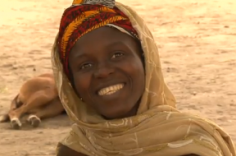Print  |
|


Videos in Baynunk – SENEGAL

A word on the Baynunk language…
Baynunk is spoken in Senegal, Gambia, and Guinea-Bissau. It belongs to the Niger-Congo language family (North Atlantic branch). The language counts around 6 200 speakers and is considered endangered by the UNESCO.
Sorosoro sent a filming crew to Senegal in April and March 2010, as part of our collaboration with the Sénélangues project launched by the CNRS based LLACAN lab dedicated to « Speech, Languages and Cultures of Sub-Saharan Africa ».
Sokhna Bao-Diop, Ph.D student in linguistics and member of the Sénélangues project, was there with out filming crew. She gives us here a full presentation of the Baynunk language.
The videos in Baynunk
The state of the language
Introduction to the Baynunk language by Sokhna Bao-Diop
Sorosoro sent a filming crew to Senegal in April and March 2010, as part of our collaboration with the Sénélangues project launched by the CNRS based LLACAN lab dedicated to « Speech, languages and cultures of Sub-Saharan Africa ».
Sokhna Bao-Diop, Ph.D student in linguistics and member of the Sénélangues project, was on the spot with out filming crew. She gives us here a full presentation of the Baynunk language.
So we’re back on the road to Casamance, with the fresh memories of not-so-relaxing filming sessions (the region is the scene of regular tensions with the local rebels), yet the amazing images we got in return were well worth the aventure. Here’s a little glimpse, and the rest is on its way…
Linguist: Sokhna Bao-Diop
Image & sound: Muriel Lutz, assisted by Cheikh Tidiane Sall
Editing: Caroline Laurent
Video created within the ANR Sénélangues project
Tales and narratives
Animal tales, told by storyteller Issouf Coly
Let’s take a journey through the land of animals, still in Senegal, in the company of storyteller Issouf Coly. We are in Niamone, close to Ziguinchor, Casamance ; and with everyone around a bonfire storyteller Issouf Coly begins tales that may remind some of the La Fontaine Fables. Though here, not a single reference to foxes or frogs: these are the forests of Africa, and the characters brought into the stories are the hyena, hare, monitor lizard, Billy goat and lion…
Those who are familiar to the fables La Fontaine or Aesop once told will have no trouble grasping the deeper sense of these stories, which undoubtedly reach beyond mere animal stories. We’d be happy to receive your comments should any of you have the keys to decipher the four tales we’ll be introducing along these next few weeks. So far, we know that the hyena is invariably present, that the hare is smart, even clever (as is the fox character in Western tales) — and that all the stories end in the same way… with a general escape!
Now… Taalintaal! May the story begin!
Tale 1: How the hyena escaped the monitor lizard
Tale 2: How the hare escaped the hyena
Tale 3: The hyena who thought she was stronger than the billy goat
Tale 4: How a child terrified the animals of the forest – Part 1
Tale 4: How a child terrified the animals of the forest – Part 2
Historical narratives, told by storyteller Sékou Djikabo Coly
First narrative: Moussa, known as « the little cat »
Second narrative: when the white man came to the village…
Linguist: Sokhna Bao-Diop
Image & sound: Muriel Lutz assisted by Cheikh Tidiane Sall
Editing: Caroline Laurent
Videos created within the ANR Sénélangues project
Music and songs
Baynunk songs
Read more
Linguist: Sokhna Bao-Diop
Image & sound: Muriel Lutz assisted by Cheikh Tidiane Sall
Editing: Caroline Laurent
Videos created within the ANR Sénélangues project
Little words for everyday use
Numbers
Colors
Body parts
In the following video, Awa Coly grants us a full-on detailed description of the parts of the body!
Weekdays
Expressions of Time and Space
Daily phrases
Linguist: Sokhna Bao-Diop
Image & sound: Muriel Lutz, assisted by Cheikh Tidiane Sall
Editing: Caroline Laurent
Videos created within the ANR Sénélangues project
Recipes
Awa Sambou is teasing our taste buds here with this traditional recipe from Niamone, in Casamance:
Dried fish on manioc leaf sauce
Linguist: Sokhna Bao-Diop
Image & sound: Muriel Lutz, assisted by Cheikh Tidiane Sall
Editing: Caroline Laurent
Video created within the ANR Sénélangues project








